|
W o m e n |
|
|
Jelogiri-e mojadad az tajamo'e zanan dar Iran
One million signature for changing women's law in Iran Please sign the petition to help our women's cause Iranian women has launched a campaign to collect one million signature demanding changes to discriminatory laws in the Iranian Laws. Please consider supporting the plight of Iranian women for equality and pass this petition to your network! The http://we-change.org/spip. php?article11# sp11 is the Persian/Farsi version of the petition.
please click on this site to sign the petition.
http://we-change. org/spip. php?article19 For reading othe articles, please click here. http://we-change. org/spip. php?rubrique9 NAZANIN TO BE RE-TRIED IN IRAN NEXT WEEK
About the Case CLICK HERE TO SIGN THE ONLINE PETITION The injustice of this case propelled Nazanin Afshin-Jam to take immediate action and start a petition to help save the life of her namesake. The petition now has over 200 000 signatures from around the world. Since initiating the Save Nazanin Campaign with Mina Ahadi- the Head of the International Committee Against Execution and Stoning- and through the help of other human rights groups and individuals, they have been able to engage the UN, Canadian Parliament, the EU, Amnesty International and others to pressure the Iranian Officials to spare the life of this child. On June 1st 2006, the Head of Judiciary Ayatollah Shahroudi announced a stay of execution and the call for a complete new retrial. Nazanin Fatehi’s retrial will take place at the end of August. In this new trial the Iranian courts will either: a) spare the life of Nazanin and release her from prison or In the meantime the Nazanin Fatehi Trust fund has been set up to help cover her legal fees and campaign costs. See Donations page. The fate of Nazanin Fatehi is still up in the air, please continue to spread the word about her case and the plight of other women in similar circumstances such as Delareh Darabi, Kobra Rahmanpour, Ashraf Kalhori, Fatemeh Haghighat-Pajouh and Malak Ghorbani and continue to pressure the Iranian Government to free these women. From her prison cell, Nazanin Fatehi wanted to thank everyone that has been working so tirelessly on her behalf and everyone who has signed the petition. Thank you, Execution of a teenage
girl
Atefah Sahaaleh: wrongly described as being 22
years old On 15 August, 2004, Atefah Sahaaleh was hanged in a public square in the Iranian city of Neka. Her death sentence was imposed for "crimes against chastity". The state-run newspaper accused her of adultery and described her as 22 years old. But she was not married - and she was just 16. Women May Have To Take Off Their Bras At Airport Security yahoo.com n order to get through security at most airports you have to take
off your shoes. Now some women might have to take off their bras.
"Gel" bras are not acceptable attire for passengers. The
little gel packet inside the bra is a no-no, according to the Transportation
Security Administration. Tunisia marks 50th anniversary of women's rights law TUNIS, Tunisia (AP) _ Tunisia celebrated its national women's day Sunday by marking the 50th anniversary of laws that revolutionized how the predominantly Muslim country treats women. Picture bleak for women in Afghanistan By FISNIK ABRASHI, Associated Press Writer
The survey warned that domestic violence against women is "hugely underreported" because of the stigma attached to it. "Acts of violence (against women) are happening with impunity," said the report, conducted by the U.N. Development Fund for Women, or UNIFEM. "It appears that the government, communities and families are not doing enough to prevent violence against women." Under the hard-line Taliban regime, which was toppled in late 2001, women were unable to vote, receive education or be employed. In recent years, some gains for Afghan women have been made, including the right to cast ballots and have female candidates run for parliament, but women are often still regarded as second-class citizens. Domestic violence, which accounts for 82 percent of the cases, is the most prevalent form of violence against women reported, according to the survey. Partners are responsible for nearly half the cases, said Meryem Aslan, the country director for UNIFEM. "The shame associated with reporting most forms of domestic violence, such as rape and other forms of sexual abuse, may contribute to the fact that women often suffer in silence," said the report, which was based on more than 1,300 cases of violence against women. Iran's unseen art
IASON ATHANASIADIS FOR THE TORONTO STAR As chador-clad female police charged the crowd with batons, the young painter's mother was dealt a heavy blow that would turn her upper right arm blue for a week. Tabibzadeh went home that evening and started painting a new tableau. "Painting is like keeping a diary," she says. "I might see a cop hitting a girl and that would affect me. I try to put myself in the position of the different actors, of the cop hitting the girl, or of the girl being hit. "I can sympathize with the man I hate because I know that side also exists in me, the side of me that I hate as a human being." Tabibzadeh is a talented 22-year-old artist and one of the most promising of a new generation of young Iranian painters. But the best of her work can never be exhibited in an Islamic Republic where the depiction of any nudity is banned. Tabibzadeh's mainly figurative work is at its best when she weaves social criticism into the dark, tormented nudes she paints, a striking contrast to the Islamic society that inspires them. Her voluptuous but tormented nudes have been criticized for being "too cynical" by the owner of one influential gallery. Making a living in the Islamic Republic of Iran selling such art is nearly impossible. The dark, primeval human landscapes that Tabibzadeh populates with naked humanity can never be exhibited publicly in Iran because of the restrictions on the public depiction of scantily-clad bodies. Aside from going against the status quo, they also challenge Iranian society's concept of conventional beauty. The new social vistas opened by reformist, two-time former president Mohammad Khatami have shrivelled in the past year of conservative rule by Mahmoud Ahmadinejad. The country has taken a reactionary turn as nuclear confrontation teeters on the edge of possible United Nations Security Council sanctions. With art buyers still visiting galleries but buying sparsely, Tabibzadeh is forced to sell her non-nude portraits for a pittance on the rare occasions she gets any interest. Drawing ample inspiration from the society surrounding her, Tabibzadeh pointedly satirizes the hypocrisy of an outwardly Islamic society wracked by sexual promiscuity and heroin or opium addiction. In one painting, a completely nude figure is covered by a headscarf — mandatory for women in Iran in all public spaces. Tabibzadeh graduated with honours from Islamic Azad University, Iran's top private art school and a breeding ground for independent minds. Typical of a generation known as the "children of the revolution," her fluent English and ease with the West belies that she has never been outside Iran except for a six-day trip to Istanbul with her family. "In some of the works, the busy background, the strong colours, the perplex line and the tortured expressions of the figures emit strength and confusion, while in others the simplicity of the design and the sober colours have a more allegorical and sensitive result," says Katerina Tselou, a Paris-based art critic and former gallery manager. Tabibzadeh's background and youth are what make her work so unique. At a time when Western media representations of Iran are almost exclusively limited to chador-clad women and Islamic propaganda, Tabibzadeh's work, presents an intriguingly explicit peek into the private lives and psyches of Iran's third post-revolutionary generation. Tabibzadeh's contemporaries have no memory of the Shah and only a dim childhood recollection of Ayatollah Ruhollah Khomeini, the vastly charismatic founder of the Islamic Republic. For a generation born during the Iran-Iraq War, their earliest vivid experience was the dreaded War of the Cities unleashed by former Iraqi president Saddam Hussein upon Iran at the climax of the 8-year war fought between the two countries. This post-revolutionary generation — who make up more than 70 per cent of Iran's population due to a baby boom in the aftermath of the revolution — will be hugely influential in shaping Iran's future over the next decade. Savvy, urban and comfortable with the West in a way their parents never were, this generation is struggling to escape the confines imposed upon it both by a clerical-dominated government that many view as backward, and by a hostile international community apparently incapable of distinguishing the vigourous currents coursing through Iranian society. "(Painting) is one of the few places where I can express myself without self-censorship — not like in the outside world, in the Islamic Republic, where a lot of people filter their words," Tabibzadeh says. And express herself she does. Gaunt, skeletal figures wrap their limbs around each other or huddle in corners, emitting a sense of alienation and enduring isolation that suffuses even the most intimate scenes. "Unfortunately, people are strangers from each other in our society, the ties that bind them are fake," Tabibzadeh says. "Even when two people are lovers here, they're so disconnected from each other." These are brave words coming from a young woman living in a society where women — despite having more rights than the majority of their Arab counterparts — face discrimination and are expected to fulfill the role of housekeeper and child-bearer. But for a new generation of young people breaking the stereotypes nurtured by their elders, Tabibzadeh's work could represent a visual unifier.
Persian Jewish Artist Finds New Freedom by Karmel Melamed, Contributing Writer http://www.jewishjournal.com/home/preview.php?id=16322
Having spent the last year in Los Angeles, the 30-something Nassi has been busy trying to make a name for herself in the local art realm while continuing to create her unique installation art works that combine various forms of media together. "From the time I have arrived here I have been passionate about producing works with various themes including the Holocaust which I would have never been able to explore in Iran," Nassi said.
Despite her tremendous achievements and acclaim, she still encountered anti-Semitism from her colleagues in Iran and was even called "Joohood," a derogatory Persian word for a Jew. "In one stance after I won one of my awards a number of people came up to me and said 'you are a Joohood girl who thinks she can be something but we'll stop you from going any further,'" Nassi said. Nassi said her Jewish identity was also a major obstacle for her in Iran since some of her works would not be displayed in many of the state-funded galleries. She was also prevented four times from enrolling in a doctoral art program at a Teheran university. "When I asked them why they would not allow me to register, they gave me different absurd reasons and I slowly realized it was because I was Jewish," she said. "Finally one of the assistants at the college told me flat out 'Miss, you are from the worst of the minority groups so don't waste your time trying to register!'" Seeing her creative energies stifled and no future for her career, Nassi left Iran and literally started with just a white canvas in the Los Angeles art scene. She has been creating more of her installation pieces with themes closest to her heart that she had never been able to explore in the past. "From the time the Iranian president made those comments about the Holocaust I can't understand how he could allow himself to make such ridiculous comments," said Nassi. "His words were really bone chilling and they loose their effect in the translation. Since I understand them and because I've seen the crematoria in Austria and Germany, it has been my goal as an Iranian Jew to depict the theme of the Holocaust in my work." Noticing her talent and ambitions, some local Iranian Jewish organizations have warmly welcomed Nassi and embraced her unique artwork. "She's intelligent, passionate about her work and very talented," said Dariush Fakheri, founder of the Eretz-SIAMAK Cultural Center in Tarzana. "We would welcome her and have in the past welcomed talented artists and writers from our community to share their works at our center". Krista Nassi's art work will appear between Aug. 12 and Sept. 2 at the Gallery 33 East in Long Beach. For more information, call (562) 433-1496. www.gallery33east.com
|
|

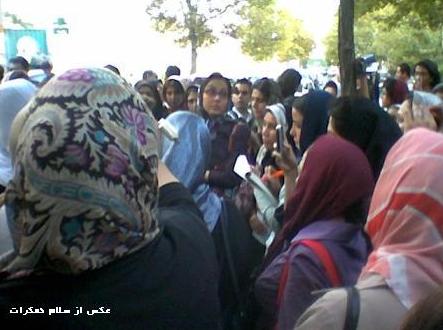
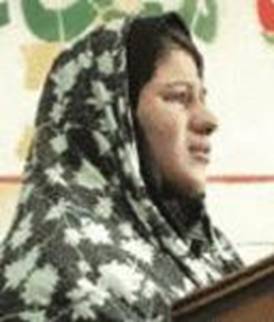
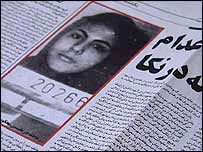
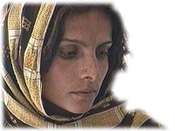
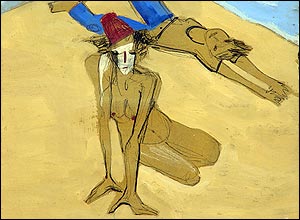
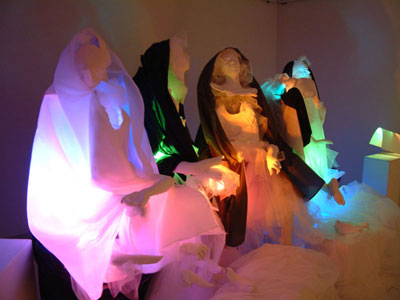
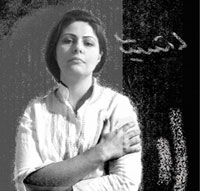 In addition
to holding a degree in graphic design from Tehran's Institute of Graphic
Design and Architecture and a master's degree in art from Tehran's
University of Art, Nassi has spent more than 10 years making a name
for herself in the art world who has shown themes ranging from women's
rights and marriage to societal issues. She has also accumulated awards
a number of international art competitions, including a Gold Medal
at the prestigious 2002 10th Asian Art Biennial competition, from
among thousands of artists in Asia.
In addition
to holding a degree in graphic design from Tehran's Institute of Graphic
Design and Architecture and a master's degree in art from Tehran's
University of Art, Nassi has spent more than 10 years making a name
for herself in the art world who has shown themes ranging from women's
rights and marriage to societal issues. She has also accumulated awards
a number of international art competitions, including a Gold Medal
at the prestigious 2002 10th Asian Art Biennial competition, from
among thousands of artists in Asia.